Indian Navy’s First Training Squadron arrives at Maputo port, Mozambique
Mozambique: Registration hits 90%, but who took Gaza’s children? – By Joseph Hanlon

Photo courtesy: ADS
Registration hit 12.9 million, claimed to be 90% of voting age adults, according to the report this morning by STAE of preliminary totals of the complete 46 day registration period which ended 30 May. But many anomalies have appeared in the totals.
Gaza gains 9 parliament seats – but only because STAE estimates that only 20% of the Gaza population are children and Zambezia 59% children, compared to 49% is the rest of the country. (See article below.) These strange figures were first noted by Prof Antonio Francisco and civil society observer group ADS.
People who registered last year did not need to register again, so total registration is calculated by combining last year and this. Registration is lowest in Niassa, which registered only 60% of its target this year and 77% overall. Tete comes next with only 72% this year and 83% overall. followed by Nampula at 72% this year and 83% overall.
Zambezia, where STAE estimated that 59% of the population were children, actually registered only 79% of voting age adults.
Gaza hit 103% of an already inflated target figure this year, which is an impossible 161% of actual voting age adults. Cabo Delgado registered 98% of its target and 99% of voting age adults, which seems suspicious.(Full provincial totals below.)
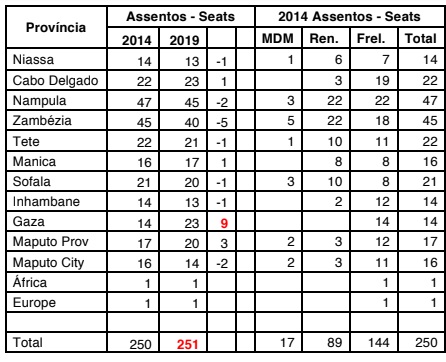
Nationally, registration hit 80% of target this year and 90% overall. Registration was 89% in 2014 and 90% in 2009.
Daily registration which hit a peak of 142,000 per day in the third and fourth weeks and then fell to 113,000 per day in the 6 week rose to 129,000 per day in the final four days.
CNE must take away 1 parliament seat
As we pointed out in the previous bulletin the law calls for an incorrect calculation of parliament seats. Based on this registration, it gives 251 seats for a 250 seat parliament. (see tables below) The CNE will be forced to decide which province loses a seat.
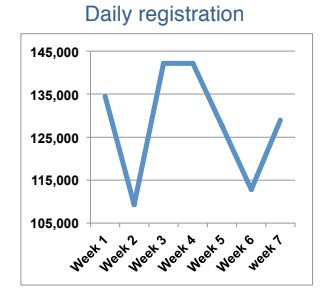
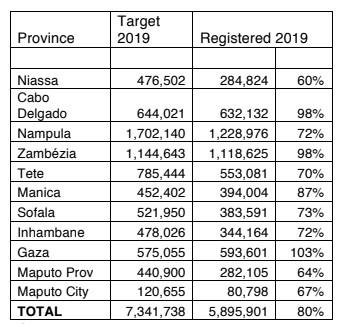
The impossible high registration in Gaza and the low registration in Nampula, Zambezia, Niassa and Tete leads to 9 parliament seats moving from the north to Gaza – a population migration not seen in the national census.
Gaza which gains 9 seats voted overwhelmingly for Frelimo in 2014, Nampula and Zambezia which lose 7 seats are dominated by the opposition. In Niassa and Tete, which lose one seat each, Frelimo and the opposition were very close in 2014.
This shift in registered voters will also have an impact on the presidential election.

Who took Gaza’s children?
Across Mozambique, half the population is of voting age – except in Gaza. STAE estimates that only 20% of the Gaza population is under voting age. And more than that inflated total of adults has registered to vote.
The table below shows the population by province from the 2017 census and the STAE estimate of voting age population (over 18 on 1i5 October 2018). We then calculate the percentages. Eight provinces are close to the national average. But three are very different.
Zambezia is estimated to have only 41% adults, while Maputo city is estimated to have 66% and Gaza 80%. This affects the registration averages.
People who registered last year do not need to register this year. When we combine 2018 and 2019 registration and correct the three provinces to have the national averages of children and adults, we find that Zambezia has the second lowest registration (after Niassa) with only 79%, while Gaza has the highest registration – 161% of adults of registered.
Antonio Francisco first pointed to the anomaly in an interview with ADS elections newsletter (2 June, Boletim ADS Eleicoes, edicao 6. available HERE to read and for download). Francisco is a professor at Universidade Eduardo Mondlane. ADS is one of the civil society election observer groups. Population figures are published in a brochure on the 2017 census (available HERE to read and for download) which makes clear that more than half the Gaza population is under 17 years old and Gaza does not have fewer children than other provinces.
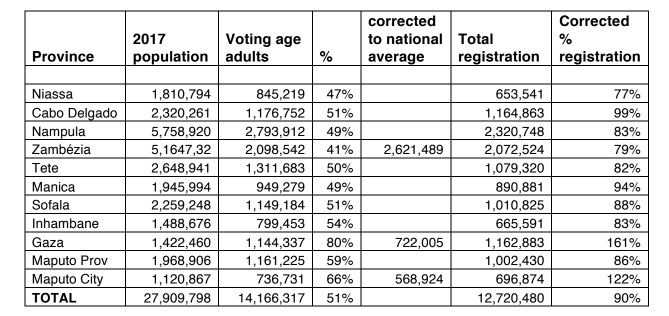
Gaza is a ballot box stuffing centre
Possible inflated registration in Gaza could be used to hide an increase in ballot box stuffing. A simple analysis of polling station data from the 2014 election shows that at least 157 polling stations – 16% of all polling stations – were involve in ballot box stuffing in that presidential election.
National turnout in 2014 was 49% of registered voters, but in Gaza is was 66%. Some of this is genuine support for the ruling party which means more people vote, but we think Frelimo also benefits from ballot box stuffing. This matters in the Presidential election, because all national votes are combined.
There were 53 polling stations where more people voted that were registered, and the votes were normally 100% for the Frelimo candidate Filipe Nyusi. Fraud in Gaza takes place particularly in the remote northern districts, which usually do not have observers and opposition party monitors. In 2014, in Masangena district 25 of 27 polling stations stuffed their ballot boxes, in Massingir 23 of 30 (including two where there were observers and which were included in the parallel vote count), and 26 of 42 polling stations in Chicualaculala. “Stuffing” ballot boxed usually does not mean putting in extra papers, but simply increasing the number of Frelimo votes when the count is recorded on the results sheet (edital).
We did two statistical tests to look for ballot box stuffing. The first is to look for impossibly high turnout. In 2014 Gaza had 1024 polling stations, and for each one we calculated turnout – the percentages of registered electors who actually vote. These are then grouped into bins or bands 1% wide, and in the graph below we present this as a bar chart below. The highest number of polling stations was 41 with a turnout of 67% – shown by the highest bar in the centre. Events such as voting follow what statisticians call a “normal distribution”, or bell curve. That is shown by the red line, which suggests voting and counting was normal in most polling stations.
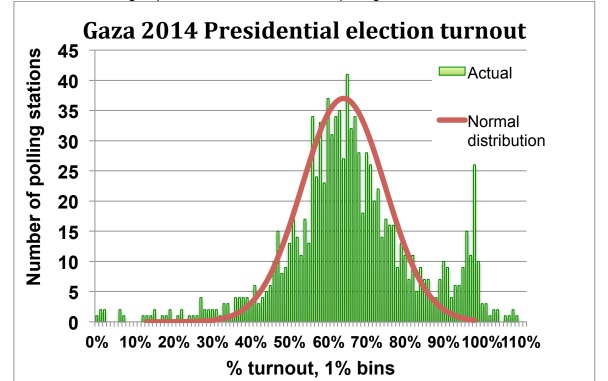
In the normal distribution, the number of polling stations falls off to left and right – fewer and more voters. But this chart shows an unexpected jump in polling stations with a turnout over 90%. there is a second peak, of 26 polling stations with a 96% turnout. There are 53 polling stations with over 100% of registered voters actually voting. This is simply impossible. People die or become ill, or are away (perhaps working in another polling station).
The bar chart and the normal distribution separate at 90%, so we consider that any polling station with over 90% turnout has been stuffing the ballot box. If we correct those 157 polling stations by only allowing the average 66% turnout, then 15,340 stuffed votes must be taken away from Nyusi.
We can do one other simple check, which has much broader implications. Sometimes polling station staff in a hurry to count and go home only stuff the presidential ballot box, but not the one for Assembleia da Republica (parliament). And, sure enough, 23 polling stations show that many more people voted for President the parliament. The most extreme case was at one of the polling stations at Julius Nyerere primary school in Xai Xai where apparently 77 people voted for president but not for parliament. If we take a total an additional 595 stuffed votes out the ballot box, we find that at President Nyusi’s total in 2014 was inflated by at least 15,935 votes..
The importance of these 180 polling stations (16% of the total) is that these are the ones who did their stuffing in a sloppy way – putting too many votes on the results sheet, of not making changes in all three elections. With more care, those polling stations would have been hidden and not noticed. This indicates that many more polling station staff were topping up the totals. Which suggests that a significant part of 66% turnout in 2014 could be fake votes. That, in turn raises questions about this year’s elections. The much higher registration could provide a cover for substantial ballot box stuffing, if done carefully.
When looking at the presidential results, the 23 polling stations looked no different than the others; it was only comparing with the parliamentary election that showed the fraud. Many others will have done the same thing, but been more careful. It is only election observers and party monitors who can prevent this. Every polling station has members of the staff nominated by opposition parties, yet they said nothing in these 180 polling stations. During the count at the polling station, the results are written on the blackboard or on a sheet of paper. Observers and polling station staff must check to see that those numbers correspond to the numbers on the edital.
Statistical checks show what is possible and that at least 16% of Gaza polling stations were committing fraud – and no one noticed. We know civil society observers were in at least two polling stations and simply reported the inflated numbers without question. Did they not see the difference between the count of the ballot papers and what was written on the edital?
There is high danger of fraud in the October elections. That can only be prevented if observers actually observe.
By Joseph Hanlon









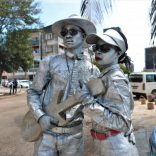

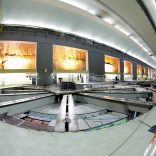

Leave a Reply
Be the First to Comment!
You must be logged in to post a comment.
You must be logged in to post a comment.